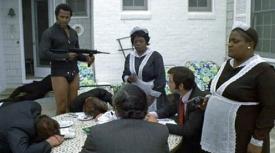Hell Up In Harlem
The Devil Says
See It
(If you're desperate for some gunplay and not picky)
Most sequels don't need to be made and Hell Up In Harlem isn't an exception. Black Ceasar was a sharp, engaging, blaxploitation flick that had a very definitive ending. Ah, but things change when money is involved.
That means it's story time. In the final act of Black Ceasar, charming and vicious hood Tommy Gibbs stumbled into a vacant ruin, dying from a gunshot wound. A group of black youths, very much like he was twenty years earlier, beat him to death just for the hell of it and steal his belongings, leaving the journal that was his real power to disintegrate on the ground. Black audiences loved the film up to that point, but turned against it (in one case violently where a woman hit writer/director Larry Cohe). They didn't want Gibbs to die and they certainly didn't want black kids to do it. Cohen liked his ending, but he liked a profitable movie even more, so he went to each theater showing the picture and cut the scene out of the reel. This doesn't change things much. By all rights Gibbs should drop over in a minute or two, but since he technically was no longer dead at the closing credits, there was room to bring him back for a sequel. (Current copies have the original ending restored.)
 So,
with a huge hit (relatively), the studio cranked out
Hell Up In Harlem
in the same year. It's a very different kind of movie: a pure
shoot'em up. People kill other people, but working out why will
just make your brain hurt. Tommy, now not dead and with his
ledger filled with blackmail material still in one piece, calls
his father (calls his father? Instead of his gang members...?)
to rescue him. After a brief hospital stay, the two rebuild his
criminal empire. I guess Dad had a personality replacement
between movies, but hey, he's cool now. When Tommy's ex is murdered, Tommy blames his
father and takes off for California with a girl who seems to
have been written into the script as an after thought. Big Daddy
(who has his own theme song) gets into a war
with one of Tommy's old lieutenants, who's thrown in with white
politicians. When Dad bites it, Tommy comes back to town and
he's in the mood for violence.
So,
with a huge hit (relatively), the studio cranked out
Hell Up In Harlem
in the same year. It's a very different kind of movie: a pure
shoot'em up. People kill other people, but working out why will
just make your brain hurt. Tommy, now not dead and with his
ledger filled with blackmail material still in one piece, calls
his father (calls his father? Instead of his gang members...?)
to rescue him. After a brief hospital stay, the two rebuild his
criminal empire. I guess Dad had a personality replacement
between movies, but hey, he's cool now. When Tommy's ex is murdered, Tommy blames his
father and takes off for California with a girl who seems to
have been written into the script as an after thought. Big Daddy
(who has his own theme song) gets into a war
with one of Tommy's old lieutenants, who's thrown in with white
politicians. When Dad bites it, Tommy comes back to town and
he's in the mood for violence.
As
long as you can ignore character continuity and development, as
well as plot and reality (Tommy flies to L.A. in an empty, but
messy, commercial jet), you'll have fun with Hell Up In Harlem.
 Where else can you find a group of brothers in scuba gear
gunning down the entire mafia on a Caribbean island with the
help of several 1930s-era maids? Damn, now that's entertainment!
You won't find out what happens to Tommy's daughter or to his
new wife, but you will see a guy impaled by an umbrella. Priorities.
Where else can you find a group of brothers in scuba gear
gunning down the entire mafia on a Caribbean island with the
help of several 1930s-era maids? Damn, now that's entertainment!
You won't find out what happens to Tommy's daughter or to his
new wife, but you will see a guy impaled by an umbrella. Priorities.
What has to disappoint any fan of blaxploitation is how little race has to do with the picture. Yes, the leads are black, and there is a funky sound track (not the planned James Brown one, but a quick and lame replacement when negotiations broke down), but, with the exception of the climax, this is black on black combat. Even the racial slurs are missing. With a quick casting change, this could be a movie about an average group of white guys.
Hell Up In Harlem is feeble compared to its predecessor and nearly incoherent. But with an action scene every five minutes and a huge body count, it is a reasonable choice for an after poker-game, drunken party.
Sins (What does this mean?)
| Pride | Nada. |
| Sloth | Nada. |
| Avarice | Nada. |
| Gluttony | Nada. |
| Aesthetics | Nada. |
| Surrogate Cruelty | The primary method of death is by bullet, but the non-gun demises are more of a kick. Death by beach umbrella is a winner, and hanging the white guy is always good. |
| Thought | Nada. |
| Humor | If you find a guy getting blown away on a New York street and falling face up with a hot dog sticking out of his mouth funny, then you'll find plenty to laugh at. By the way, I do find that funny. |
| Lust | A quick, minimalist sex scene with a breast. |


